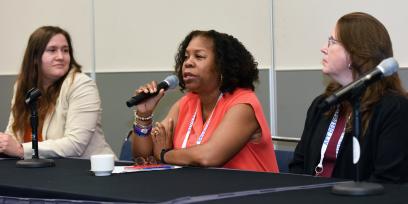AFT members know that community schools can be game changers: They improve student and staff retention, decrease absenteeism, increase graduation rates and improve morale. At the community schools breakfast Tuesday morning, participants learned more about how these schools work—and how they can implement them in their own districts—from a panel of members who shared best practices, hoping to help others build on their successes.
AFT community schools expert and assistant director Dena Donaldson assured participants that they are not alone as they embark on the sometimes daunting process of building and trying to sustain community schools. The movement is full of other union members engaged in this work. Not only do they gather up wraparound services for their students and families, they ask what families need, find out what resources are already available and make connections with the businesses, faith-based groups and others surrounding their schools to figure out how they can build a supportive community together.
Many successful strategies are relationship focused. Karen Alford, vice president for elementary schools for the United Federation of Teachers in New York City, described taking political candidates to visit successful community schools in Cincinnati and securing promises that they would support them in their own district. New York City now has 200 new community schools and a robust system to support them. Sonya Romero Autrey, elementary vice president for the Albuquerque Teachers Federation, helped create a cohort of educators who immersed themselves in union-sponsored sessions, learning how to create community school classrooms and engaging more deeply in existing community school infrastructure so that it continues to be teacher driven.
Mary Moriarty, a community schools coordinator from Hammond, Ind., is proud of the tutoring sessions she helped establish with partnerships among students, families, McDonald’s and Purdue University, whose students tutor younger children. Autrey helped establish a “family room” at one school, where primary caregivers can grab a coffee, share treats and socialize in their own space, right at the school. Alford described pulling in UFT retirees to tutor students.
The conversation also covered funding possibilities, training, partnerships with businesses like laundromats and barbers, the use of surveys to determine what communities need most and more. Participants left with ideas they can implement in their own schools, and with new resources—their fellow union members—who can help them.
[Virginia Myers, photos by Russ Curtis]

